By: Ghazal Mostafa
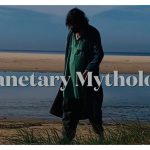 History, memory and the post-tribal inform the work of Persian-born artist Firouz FarmanFarmaian, whose lifetime of living in exile in Paris, in Andalusia and in North Africa profoundly influenced both his creative practice and individual character. “It is circumstance that ultimately shapes lives,” says the artist, whose work seeks to actively engage in bridging dialogues between past and future, east and west, archaic craft and innovative technology. As such, his compositions possess a vivacious and spontaneous energy, as well as a deeply symbolic quality, which speak to a multiplicity of currents in planet preservation politics, art and philosophy.
History, memory and the post-tribal inform the work of Persian-born artist Firouz FarmanFarmaian, whose lifetime of living in exile in Paris, in Andalusia and in North Africa profoundly influenced both his creative practice and individual character. “It is circumstance that ultimately shapes lives,” says the artist, whose work seeks to actively engage in bridging dialogues between past and future, east and west, archaic craft and innovative technology. As such, his compositions possess a vivacious and spontaneous energy, as well as a deeply symbolic quality, which speak to a multiplicity of currents in planet preservation politics, art and philosophy.
Originally rooted in Persian lore and focused on themes of nature, architectonics and the interplay between real- ism and abstraction, Farman Farmaian’s ever-evolving body of work presents deep underlying explorative segments united by common motifs of movement and texture. The raw and visceral emotion of his pieces is tempered by material properties often produced and sourced within the framework of tribal collaborative craftsmanship. Each work is the result of careful contemplation of the techniques and tools that achieve
a singular aesthetic and emotional intention. These in turn are deftly combined to create a unique visual rhythm across a wide range of media, including painting, sculpture, film, music and
VR. Farman Farmaian lives and works between Andalusia and Marrakesh.
Please tell us about yourself and your background.
I’m the oldest of my siblings, my brother Teymour (Architect) and sister Ayshé (Professor). I live with my wife Camilla and our two dogs in Sotogrande, Spain, but we’re in the process of re locating to Athens. I was born in Tehran but grew up between Paris, Marrakesh and Andalusia (Spain) in my post-revolution displaced family, navigating boarding schools, prep schools and universities. Luckier than most other uprooted youngsters my age, my parents were still able to provide me with schooling modeled by the international education that is the FarmanFarmaian way of excellence. My education was in fact embodiment of the compelling lessons of our family’s revered ancestor, Shazdeh Abdol-Hossein FarmanFarma who believed in pursuing a scholarly education that integrates the traditional with the forward looking.
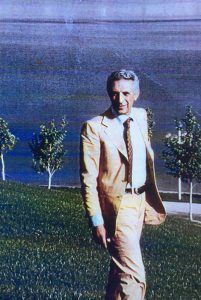
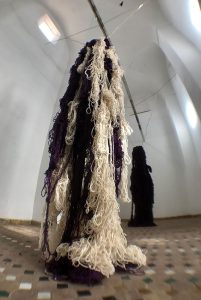
(AbdolAziz Farman- Farmaian)
Despite my parents’ desire to have me take on my grandfather’s line of work as an Architect (AbdolAziz FarmanFarmaian is celebrated as the former Shah’s crowning builder and his legacy positions him as the Middle East’s most influential architect) I chose to trust an inner call and engage in an avant-garde artistic exploration – keeping in line with my dear late great aunt Monir FarmanFarmaian.
As a side, I should tell you about Monir to describe my choice of following in her footsteps. Monir was a force. First married to Iranian abstract painter Manoucher Yektai, she left postwar Iran for New York City to establish herself as an artist- a feat in itself for an Iranian woman of her era. Once in New York she joined the bustling art scene befriending the likes of Andy Warhol, Robert Rauschenberg, and Frank Stella. In the late fifties, after marrying my uncle Abol Bashar FarmanFarmaian, Monir went on to be celebrated in uppermost international art circles as one of the planet’s best. Her vision layered traditional Persian technique with conceptual contemporary form. A beacon.
After two years of attending Architecture School at Paris Beaux-Arts, I changed course and enrolled in the Art school at the Beaux-Arts and soon started to paint using multidisciplinary material such as nomadic designed fabrics, industrial glue on wood, or acrylic markers and plastic paint with a lot of texturization, asserting a first presence on the competitive Paris art scene.
As a multidisciplinary artist, how do you describe your work? What inspires you the most? What are the main materials and mediums that you use?
What is the main reason behind your diverse choice of material? What are the main ideas that traversed your work?
On my Instagram Bio Line, you will find me described as a Multivalent Retro Futurist.
The term ‘multivalence’ reflects a plural, multidisciplinary and interconnected – interwoven – approach to any practice. Each medium is a tool embedded in the larger idea of my palette – each tool is intimately married by one movement to the next giving the end result its final imperfect, ever evolving balance as in a Sufi harmony. I use film, sound, paint, VR technology and sculpture, weaving them into a multi-sensory immersive experience.
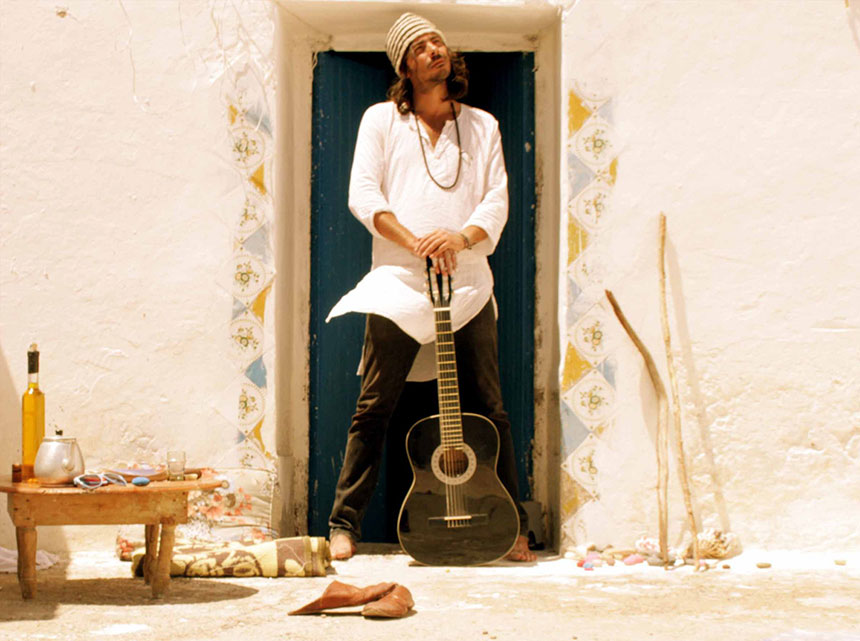
Retro Futurism is not a new concept. It references 1930’s art deco futuristic visuals and Fritz Lang’s Retro SciFi vision as seen in the movie Metropolis,
later to be repurposed in the sixties and seventies by art circles. I chose to widen the scope to the exploration of the thematic related to the tension and the connection between past and future, archaic and innovative.
With respect to the materials that I work with, I have moved from raw canvas, natural pigments, acrylic and plastic paint to a process-oriented method where I source all my material in connection to the specificity of my project and/or particular painting, often engaging in collaborative exchanges with the world of crafts.
You have your own way with music from being the founder and lead singer of electro rock band “PLAY- GROUND” and your first solo album “Vagabond Heart”, to sonic signatures in your exhibitions.
Tell us more about it.
I acquired my first Spanish guitar around the same period that I joined Artistes Associés (a 90´s Graffiti Collective) as a teenager spraying frescoes on suburban walls and subway wagons and had a first whiff of stage life with a retro rock outfit patched together in boarding school.
The urge to put together a functional band followed me up to art school (The Velvet Underground and Andy’s Factory played a role in the choice of the band’s name, PLAYGROUND). By then, I had started experimenting with sound, film and image via a string of avant-garde Super 8mm short films and ethno-music documentaries ( Ava400A- sa, The Destiny of Nathalie X, The Gnawa Trail ) that had a fair lifespan considering the quasi-non-existent Parisian underground scene (we did not join the French hip-hop movement).
Most of the crowd I was shooting films with were first class musicians. Unforgettable jam sessions multiplied. Out of those sessions PLAYGROUND was born. A fabulous time: we had plugged into the early 2000’s rock revival, rolling down from NYC – fueled by the likes of John Casablancas and Jack White. Our demoes went right up to Virgin Music Paris A&R and a frantic bid to sign us raged on the indie scene for months.
We settled for the friendly approach of an upcoming label holed up in Montmartre – Le Village Vert Records- turning down various offers coming from major labels. PLAYGROUND would be fiercely inde- pendent – a trait that has defined me pretty well through the years.
From 2003 up to 2010 PLAYGROUND toured extensively, recorded, produced and dropped hundreds of original tracks and remixes – a curated selection of which you can find on my website*. PLAYGROUND was always one to experiment, open to collaborations with different types of producers such as Daniel Presley (Faith no More, The Breeders), Dimitri Tikovoï (Depeche Mode, Placebo) or Eric Chédeville (Daft Punk, Sebastien Tellier). The irony of it all was that the band split just as we hit gold in 2010.
A Vagabond Heart is a farewell to the music industry. A very personal and internal work that followed the general unleashing of negative energies leading to the band’s dissolution. I regrouped reconnecting with Morocco: a heartfelt land and a second country since my father Tino rebuilt a beautiful life in the Kingdom following our forced exile and the Islamic Revolution.
I retreated to Essaouira – capital to the Gnawa Brotherhood (I had come close to shooting the Gnawa Trail documentary at the inaugural 1999 Essaouira Festival) and their powerful healing immemorial cosmogonic music built on a peculiar mix of African Animism and Muslim Sufism. I wanted a reconnection to a needed sense of spirituality and to nature; a refuge to write and meditate on the paths ahead.
Part of those meditations included the teachings of Iranian philosopher Dariush Shayegan (and later those of Joseph Campbell and his Power of Myth): to operate a successful ecology of the planet there exists the need to reconnect to the elements and operate on an ‘Ecology of Soul’. In the face of mounting planetary (and interplanetary) challenges I am convinced that we are in urgent need for radical change. As the central French writer-thinker and De Gaulle’s Minister of Culture André Malraux lays it: ‘The 21st century will be spiritual or will not be [at all].’
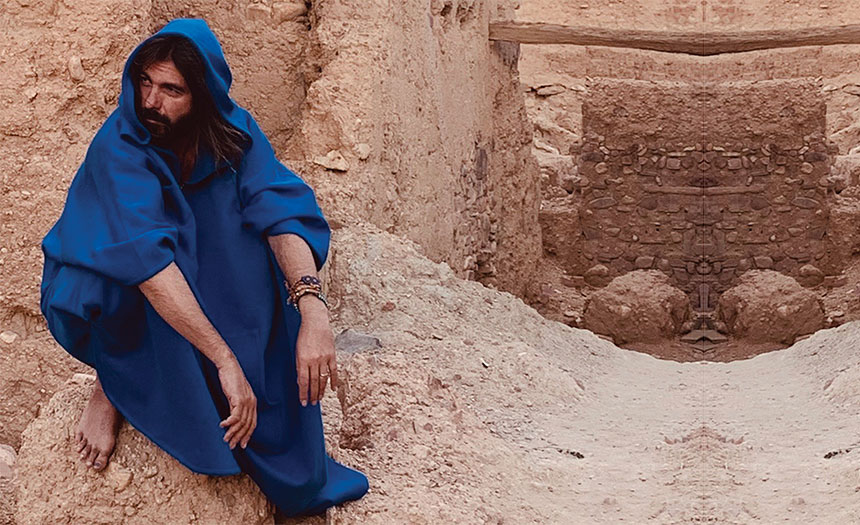
The necessary experimentations involve free association of form: a radical liberation from limiting formats, confining structures and the enclosing of culture- mirroring the unstoppable shift from indigenous (national) identities to a unique multicultural planetary identity.
The necessary experimentations involve free association of form: a radical liberation from limiting formats, confining structures and the enclosing of culture- mirroring the unstoppable shift from indigenous (national) identities to a unique multicultural planetary identity. On these founding ideas I engaged in the creation of a series of versatile nomadic installations around the world as I simultaneously created FORRM, a collaborative sonic platform with which I currently produce the Soundscapes that accompany exhibitions and Film Poems.
What is the main theme of your book “RUN”? What inspired you to write?
As I state in its opening pages, RUN was a diary, a therapist and a companion as I took the exit door toward castles made of sand, so to say.
RUN was written alongside the Vaga-bond Heart album. One fed the other. After the PLAYGROUND Record deal with Zadig & Voltaire Music / Sony ATV went to the wall – my time in Paris was over. I took a one-way train ride out to the city of Arles, in Provence
in southern France. Founded by Julius Caesar at the commercial crossroads of Gaul, Italy and Spain – Arles holds a superb archeological museum on the river Rhône, a powerful immersion into Roman classical antiquity (a period of history I am deeply passionate about).
I crossed into Spain via the Pyrenees mountains – then flew to China and survived a frozen winter in the company of an old boarding school friend who had himself ran off to resettle in Beijing. Moving into his very traditional Chinese house just across a Buddhist temple, I set up an atelier for three consecutive months and savored using Chinese ink calligraphy brushes and rice paper. But my sojourn in China did not last for long – so I made it back to Essaouira and to the Marrakech Medina – where I got run down by an old brown Mer¬cedes at dawn one morning!
From that point on a true creative reconstruction began….It’s all there, in the RUN.
As you mentioned, there are illustrious artists’ names in your family, such as your late grandfather, Abdol-Aziz Farmanfarmaian, and your late great aunt, Monir FarmanFarmaian. How did artistic endeavor become almost a family tradition? How and in what way(s) is your art influenced by these iconic figures?
I mentioned both my grandfather Aziz and my grand aunt Monir along the commanding prominence of Shazdeh FarmanFarma earlier. But will share two family anecdotes that have shaped me.
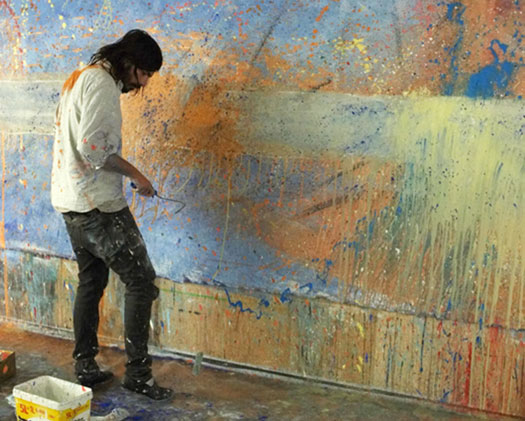
We left Iran in January 1979 on a PanAm flight to Paris. Aziz had married my grandmother Leyla (Lili) Ghara-gozlou after WWII The Gharagozlous were the khans of Hamadan, but on her mother’s side Lili was half French of aristocratic stock. Paris had been her city all along, and we owned an apartment with a view on the Ranelagh Park not far from the Musée Marmottan to whom the Monet family had donated a segment of his Nymphéas panels. Aziz took me there many times, sitting me on a bench in front of Monet and ordering me to stay silent and absorb the art. These moments embody the foundation of my love of paint and of Monet as one of my most important references. Over time those silent absorptions taught me the meaning of the quasi-abstract movement, the connection to nature, the inner understanding of the power of Beauty.
As I grew up, my father supported my natural penchant and encouraged me to take up the brush. He had always disliked Paris and had bought property South of Spain where he could give full reign to his passion for polo. When I visited him on breaks from boarding school, I would spend my time sketching the horses and the players from the side of the field – to later recreate them on canvas with oil paint using impressionist techniques. At around the age of 18 my parents sent me to NYC to stay with my aunt Monir. I came with a polo painting in my bag as a gift. I always remember how she looked up with a flash of steel in her eyes as she scanned it and said: “Never let go”.
Never let go.
Your wife Camilla FarmanFarmaian is a curator, and a cultural producer. Has her artistic point of view inspired you in any way? Tell us about PATIOO.
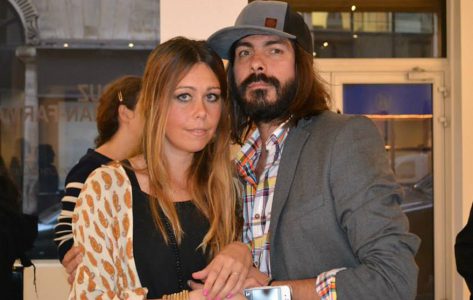
Camilla and I first met way back in 2003 as PLAYGROUND was picking up. Yvan Tayeb (a reputed Parisian manager) had booked us 4 nights a week at the Chesterfield Café off the Champs Elysées on a month-long gig marathon. Camilla was then studying Fashion marketing at ESMOD and was operating extras for Yvan at the Chester. She was thoroughly unimpressed by superfluous Rock & Roll antics. She always saw and zoomed in on the elemental and intrinsic aspects of art.
Later, she chose to work with the Press Office of the Japanese A-Net Bureau fashion line, seduced by the minimal tradition of Japanese design, and also for the House of Balenciaga at the height of Nicolas Ghésquiere’s fame – at his most creative. As she moved from fashion into the art scene, she brought with her an eye that mixes postmodern conceptual with raw beauty, taking no prisoners.
From the very start she has taught me how to never compromise to achieve true vision, to value and On a purely artistic level she has added air to my style by letting go of the ornamental – and by focusing on the core, the absolute essence. These words aptly portray her touch as an avantgarde gallery owner and curator within the framework of her digital and physical programs on such platforms as Nouvelle Vague Art spaces, We R the Nomads Agency and more recently with PATIOO MONOROOM.
Inaugurated in September 2020 in Sotogrande in southern Spain, PATIOO feeds on the ongoing urban decentralization movement fueled by the pandemic. The exhibition is a conceptual white box with a dogma: one artist, one artwork revolving every three months with a curatorial line set on technology, video art and installation.
Her tight lineup of handpicked artists includes NY based Norwegian light and video artist Anne Katrine Sens-tad, London based Iranian sculptor and installation artist Farnoush Amini, Chicago based Israeli Video Artist Alina Orlov, and Tehran based Pop Art Painter Amir Nasser Akhlaghi-Fard, as well as Parisian multidisciplinary Contemporary Artist Frédéric Atlan and Photographer Manolo Espaliú of Seville.
How has the Covid-19 pandemic impacted your work? Tell us about your experience with virtual exhibitions during the pandemic such as “Traces Sound Walk”. Do you think that the pandemic has changed the art scene forever or at least for the foreseeable future?
I have used the time off during the pandemic to explore innovative tech solutions. I first looked into augmented VR online viewing rooms (such as Berlin based VR platform Kunstmatrix) launching TRACES VR on the occasion of the digital edition of Frieze London 2020.
But I felt frustrated by the limitations of screen experience just as in early 2021 the crypto boom opened unprecedented and unchecked avenues into the decentralized Metaverse, and block-chain-secured crypto collectibles
went through the roof. This was the rise of NFT’s (Non-Fungible Tokens) in the crypto market.
I feel NFTs give true import to the undervalued sphere of digital art and create a new platform for physical art enhanced into digital editions (effectively locking royalties).
In keeping with my position via-a-vis NFTs, in March of 2021 I dropped the “NFT ART NOT NFT TRASH” public declaration as one of my first NFT activities, radically denouncing the avalanche of trash selling at insane prices like the pre pandemic excesses of the Art-world.
I believe that the way ahead lies in a qualitative integration of technology into the creative palette. The new frontier is a dynamic merge of the physical and the virtual. I went on to experiment with the Oculus Quest II VR headset plugging into apps that enable me to design, export, import and transform creations in the framework of a virtual studio. The experience led to the creation of various VR immersive experimental projects set in the Metaverse (details available on www.firouzfarmanfarmaian.com).
These explorations further convinced me that the post pandemic art scene needs radical change, a redefinition that would exclude established art world deities. Mentalities are muting, art forms and cultures are merging, new forms are arising. We must learn to welcome the 2020’s in this environment of change and transformation.
What is the story behind your latest exhibition “Memorandum of the Unknown Path” which was nominated for the Jameel Prize 2021?
Morocco for me filled the void created by exile. It started a cultural connection that began way back in 1999 with the production of my first ethno-musical documentary on Gnawa music. This connection lasted right up to the Memorandum installation-exhibition in 2020 that I produced in collaborative fashion with Berber women weavers of the Moroccan Sahara, and that was shown under the powerful cupola of the Marrakech’s Royal Theatre on the occasion of the 1-54 African Art Fair.
Primarily conceived as a fabulous dance based on Berber tribal culture, Memorandum of the Unknown Path is also a Blueprint – a referential show – a foundation on which I am creating future installations. The installation has a multilayered format built around the idea of a virtuous cycle. The approach is to source, produce, and transform in order to preserve, thereby integrating a positive collaborative dynamic. At its heart lies the idea of relating to archaic forms issued from tribal cultures merging the past and the future into a single transformative movement. As Kandinsky or Picasso had done in their own time – to develop new forms through initiating a conversation with tribal art.
The Post Tribal show on the other hand, is an Ecology of Soul, a necessary bridge to be built to reconnect to deep planetary values our collective ancient cultures have kept intact, redeemed from the devastation of the post-industrial age.
Can you describe the project you are most proud of?
Any project for me lies within the bigger picture: My whole body of work is The Project, a construct of interwoven shows linked by a common memorial thread connected by tribal cultures. You can say this post tribal vision is an approach inspired by French-Caribbean thinker Edouard Glissant’s idea of the memorial trace, and positively deconstructing Jacque Derrida’s darker input.
The dynamic was primarily established with the Nomadic Displacement, a site-specific installation in 2017 at the Musée de Marrakech, soon solidified by the Poetry of the Tribe exhibit in Tribeca NY in 2018 (Salomon Arts Gallery, Leonard Tourné Gallery) and later with Permanence of Trace in Mayfair London in 2019 ( We R the Nomads Agency, Space 50). In 2020 Memorandum of the Unknown Path at Théâtre Royal de Marrakech (We R the Nomads Agency, Magic of Persia Foundation, Flora Family Foundation) unified my visions under one dome – establishing the actual multivalent open format.
Please tell us about your upcoming projects, including shows, exhibitions and so on.
I will be going to Kyrgyzstan in a few days to stay through November 2021. There I will source, produce and create the central segment of my upcoming installation-exhibit, GATES OF TURAN with the collaboration of the Ministries of Culture and Foreign Affairs of the Kyrgyz Republic for the Venice Biennale 2022.
Produced by the We R the Nomads Agency and curated by Sveva Manfredi Zavaglia, the project enjoys the backing of a strong team of professionals along with the support of past and potentially new partnerships. For me it’s also a starting point to explore the Central Asian tribal culture and to also reconnect to my own clan’s long-lost lore.


